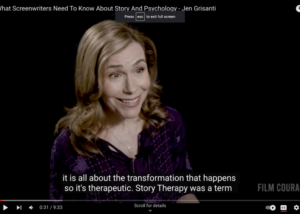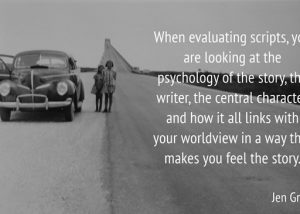I am fascinated by this idea of structure versus emotion and which is considered to be a stronger choice when it comes to writing or presenting. Is it more important to “structure” your story or presentation in a way that gives your audience a clear concise view of what it is you’re trying to say? Or, is it more productive to focus on what you say and how it’s going to make your audience feel? The obvious answer is to try to perfect both; however, I am beginning to wonder if emotion trumps structure when it comes to delivering a strong message.
Among the movies that I’ve seen and really enjoyed this year are Crazy, Stupid Love, Midnight in Paris, The Help and The Debt. I’ve noticed that the structure could have been stronger in all four films but it’s the emotion that comes to the forefront and that makes me forgive any structural imperfections. Seeing that this year’s box office favors this type of film made me think about the idea of emotion versus structure and the way that I teach story. I am a story analyst, so structure has always been the biggest way I determine whether a story works or not. I am a follower of Joseph Campbell and Aristotle. Furthermore, my career as a former studio executive has made structure the base of my foundation. On the other hand, I am also a middle child and I appreciate when people rebel against structure and choose to be spontaneous – as long as the emotion is there.
In Crazy, Stupid Love, I enjoyed witnessing all the stupid things people of all ages do in the name of love. So, the fact that the B and C story often came to the top didn’t bother me so much because it was all in effort to elevate the A story. In Midnight in Paris, I loved the pure wish fulfillment of being able to explore a time period and socialize with literary heroes so much, that it didn’t bother me that our central character’s dilemma wasn’t defined in a clear enough way at the beginning to make us understand the trigger for him to go into this world. Not to mention, that there was no explanation of how it happened other than him getting into a coach at midnight, which was very fairy tale like. Interestingly, the emotions that these stories made me feel did overpower my desire to see a more perfect structure in them. In The Help, I wasn’t sure who the protagonist was: Skeeter or Abelene. It was Skeeter who had the early goal in the story, but it was Abelene whom we empathized with. Truthfully, it didn’t matter so much as I sat watching the film with my mom and my sister, enjoying the feeling of empowerment from the story. In The Debt, I loved the idea of a choice made thirty years earlier and the regret and guilt that plagues Helen Mirren’s character as a result of that choice. This experience was so universal to me and really made me empathize with the character. Due to the structure of the flashbacks, I wasn’t totally clear on the motivation behind going after the doctor until half way through the movie but it was a minimal bother because of the strength of the story.
The analyst part of me feels that had the structure been stronger in these four films, the audience would have connected with them even more. However, the more intuitive and emotional side of me loves these films just the way that they are because they left a mark on me emotionally.
When it comes to presenting, I often find myself in the opposite place. I tend to rebel against some of the rules of how to present with regards to “ums” and “ands” or learning to take deep breaths in between thoughts. I also tend to put more on my slide presentations than I should because I want my classes to get all of the information. I know that these go against structure but I find that my main goal is to make my audience FEEL what I am saying. I know that if my audience feels my intent, it will create more “aha” moments and they will get more out of the experience. This is what the rebel in me thinks, however, I know if I could learn to master both paths, it would make an overall stronger experience for my audience.
Bottom line, learn how to master structure while elevating the emotion in the stories you tell and the topics that you present. Having a balance of both will increase your chances of a more successful outcome. Embrace the rebel in you and learn how to be spontaneous within structure. Recognize the value of emotion and utilize your own universal life experiences in the stories that you tell. This will help your audience to see you in your story.





Leave A Comment
You must be logged in to post a comment.